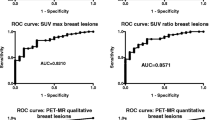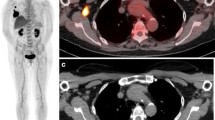Abstract.
The aim of this study was to compare MRI of the breast with 18F-fluoro-deoxy-glucose (FDG) positron emission tomography (PET) in patients with suspected local or regional breast cancer recurrence or suspected contralateral breast cancer. Thirty-two patients (mean age 57.2 years, age range 32–76 years) with suspected loco-regional recurrence (n=19), chest wall recurrence (n=5), and suspected secondary tumor of the contralateral breast (n=8) underwent MRI of the breast and FDG PET of the whole body and breast region. Cytology/histology (n=17) or a clinical follow-up examination (n=15) with additional imaging served as the standard of reference. A McNemar test was performed to compare PET and MRI, and kappa was determined to quantify agreement of both methods. Sensitivity was 79 and 100%, specificity was 94 and 72%, and accuracy was 88 and 84% for MRI and PET, respectively. Additional metastases outside the field of view of MRI were found in PET in 5 patients. In this study both imaging methods had comparable accuracy. The detection of distant metastases with whole-body PET imaging can influence patient management.


Similar content being viewed by others
References
Adler LP, Crowe JP, al-Kaisi NK, Sunshine JL (1993) Evaluation of breast masses and axillary lymph nodes with [F-18] 2-deoxy-2-fluoro-D-glucose PET. Radiology 187:743–750
Wahl RL (1998) Overview of the current status of PET in breast cancer imaging. Q J Nucl Med 42:1–7
Brix G, Henze M, Knopp MV, Lucht R, Doll J, Junkermann H, Hawighorst H, Haberkorn U (2001) Comparison of pharmacokinetic MRI and [18F] fluorodeoxyglucose PET in the diagnosis of breast cancer: initial experience. Eur Radiol 11:2058–2070
Eubank WB, Mankoff DA, Takasugi J, Vesselle H, Eary JF, Shanley TJ, Gralow JR, Charlop A, Ellis GK, Lindsley KL, Austin-Seymour MM, Funkhouser CP, Livingston RB (2001) 18Fluorodeoxyglucose positron emission tomography to detect mediastinal or internal mammary metastases in breast cancer. J Clin Oncol 19:3516–3523
Bender H, Kirst J, Palmedo H, Schomburg A, Wagner U, Ruhlmann J, Biersack HJ (1997) Value of 18fluoro-deoxyglucose positron emission tomography in the staging of recurrent breast carcinoma. Anticancer Res 17:1687–1692
Orel SG, Schnall MD (2001) MR imaging of the breast. Radiology 220:13–30
Mumtaz H, Davidson T, Hall-Craggs MA, Payley M, Walmsley K, Cowley G, Taylor I (1997) Comparison of magnetic resonance imaging and conventional triple assessment in locally recurrent breast cancer. Br J Surg 84:1147–1151
Friedrich M (1998) MRI of the breast: state of the art. Eur Radiol 8:707–725
Kraemer S, Schulz-Wendtland R, Hagedorn K, Bautz W, Lang N (1998) Magnetic resonance imaging in the diagnosis of local recurrences in breast cancer. Anticancer Res 18:2159–2162
Rieber A, Merkle E, Zeitler H, Gorich J, Kreienberg R, Brambs HJ, Tomczak R (1997) Value of MR mammography in the detection and exclusion of recurrent breast carcinoma. J Comput Assist Tomogr 21:780–784
Gilles R, Guinebretiere JM, Shapeero LG, Lesnik A, Contesso G, Sarrazin D, Masselot J, Vanel D (1993) Assessment of breast cancer recurrence with contrast-enhanced subtraction MR imaging: preliminary results in 26 patients. Radiology 188:473–478
Dao TH, Rahmouni A, Campana F, Laurent M, Asselain B, Fourquet A (1993) Tumor recurrence versus fibrosis in the irradiated breast: differentiation with dynamic gadolinium-enhanced MR imaging. Radiology 187:751–755
Hathaway PB, Mankoff DA, Maravilla KR, Austin-Seymour MM, Ellis GK, Gralow JR, Cortese AA, Hayes CE, Moe RE (1999) Value of combined FDG PET and MR imaging in the evaluation of suspected recurrent local-regional breast cancer: preliminary experience. Radiology 210:807–814
Bettinardi V, Pagani E, Gilardi MC, Landoni C, Riddell C, Rizzo G, Castiglioni I, Belluzzo D, Lucignani G, Schubert S, Fazio F (1999) An automatic classification technique for attenuation correction in positron emission tomography. Eur J Nucl Med 26:447–458
Hudson HM, Larkin RS (1994) Accelerated image-reconstruction using ordered subsets of projection data. IEEE Trans Med Imaging 13:601–609
Fischer U, Kopka L, Grabbe E (1999) Breast carcinoma: effect of preoperative contrast-enhanced MR imaging on the therapeutic approach. Radiology 213:881–888
Palmedo H, Bender H, Grunwald F, Mallmann P, Zamora P, Krebs D, Biersack HJ (1997) Comparison of fluorine-18 fluorodeoxyglucose positron emission tomography and technetium-99m methoxyisobutylisonitrile scintimammography in the detection of breast tumours. Eur J Nucl Med 24:1138–1145
Strauss LG, Conti PS (1991) The applications of PET in clinical oncology. J Nucl Med 32:623–648
Moon DH, Maddahi J, Silverman DH, Glaspy JA, Phelps ME, Hoh CK (1998) Accuracy of whole body fluorine-18-FDG PET for the detection of recurrent or metastatic breast carcinoma. J Nucl Med 39:431–435
Cook GJ, Houston S, Rubens R, Maisey MN, Fogelman I (1998) Detection of bone metastases in breast cancer by FDG PET: differing metabolic activity in osteoblastic and osteolytic lesions. J Clin Oncol 16:3375–3379
Hillner BE, Ingle JN, Berenson JR, Janjan NA, Albain KS, Lipton A, Yee G, Biermann JS, Chlebowski RT, Pfister DG (2000) American Society of Clinical Oncology guideline on the role of bisphosphonates in breast cancer. American Society of Clinical Oncology Bisphosphonates Expert Panel. J Clin Oncol 18:1378–1391
Ahmad A, Barrington S, Maisey M, Rubens RD (1999) Use of positron emission tomography in evaluation of brachial plexopathy in breast cancer patients. Br J Cancer 79:478–482
Heywang-Kobrunner SH, Schlegel A, Beck R, Wendt T, Kellner W, Lommatzsch B, Untch M, Nathrath WB (1993) Contrast-enhanced MRI of the breast after limited surgery and radiation therapy. J Comput Assist Tomogr 17:891–900
Keyes JW, Watson NE, Williams DW, Greven KM, McGuirt WF (1997) FDG PET in head and neck cancer. Am J Roentgenol 169:1663–1669
Acknowledgements.
This study was partly supported by a grant from the Legat Frau Henriette Rossiez Treichler, Zurich, Switzerland. G.W.G. is an award winner of the Research and Education Fund of the European Association of Radiology. We thank M. Griff for help in preparing the manuscript and T. Berthold, C. Britt, L. Meier, and M. Farrell for their excellent technical assistance.
Author information
Authors and Affiliations
Corresponding author
Rights and permissions
About this article
Cite this article
Goerres, G.W., Michel, S.C.A., Fehr, M.K. et al. Follow-up of women with breast cancer: comparison between MRI and FDG PET. Eur Radiol 13, 1635–1644 (2003). https://doi.org/10.1007/s00330-002-1720-8
Received:
Revised:
Accepted:
Published:
Issue Date:
DOI: https://doi.org/10.1007/s00330-002-1720-8




